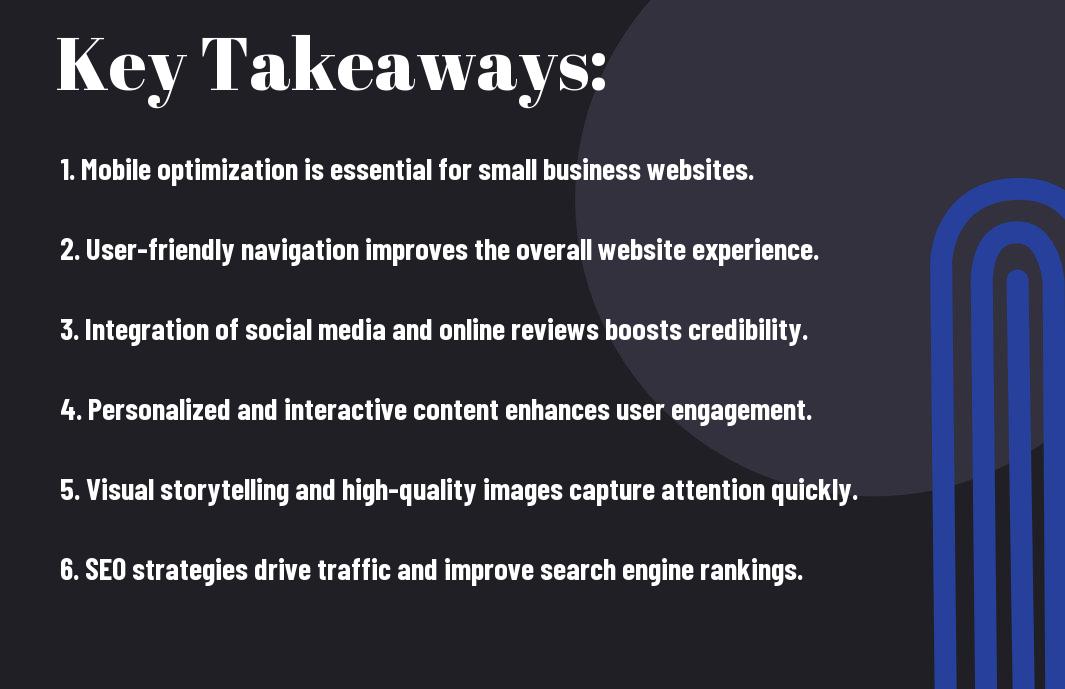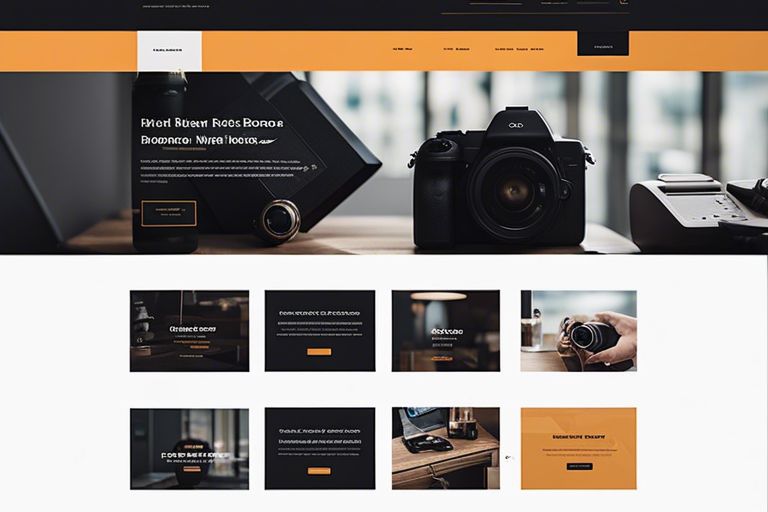As a small business owner, staying ahead of the game when it comes to your website design is crucial for attracting and retaining customers. In today’s competitive online landscape, it’s important to keep up with the latest trends to ensure your website reflects your brand’s identity and engages your audience effectively. From mobile optimization to interactive storytelling, here are the top trends in small business website design that you need to know about to elevate your online presence and drive growth for your business.
Key Takeaways:
- Mobile-first design: Ensuring websites are optimized for mobile devices is crucial, as a majority of users access websites through their smartphones.
- Minimalist approach: Small business websites are adopting clean and simple designs to improve user experience and reduce clutter.
- Interactive elements: Incorporating interactive features such as chatbots and personalized experiences can enhance user engagement on small business websites.
- Accessible design: Making sure websites are accessible to all users, including those with disabilities, is becoming a priority for small businesses.
- SEO-friendly content: Small business websites are focusing on creating high-quality and relevant content to improve their search engine rankings and attract more traffic.

Mobile-First Design Approach
The mobile-first design approach is essential for small business website design. With the increasing use of smartphones and tablets, a mobile-responsive website is non-negotiable. If your website is not mobile-friendly, you are likely to lose potential customers. According to 24 Top Web Design Trends to Dominate 2024, mobile-first design is one of the top trends to watch out for in the coming years. This trend emphasizes the importance of designing your website for mobile devices first, and then adapting it for larger screens. This approach ensures that your website looks and functions flawlessly across all devices, providing a seamless user experience for your visitors.
Responsive Design Fundamentals
When it comes to small business website design, responsive design fundamentals are crucial. Responsive design ensures that your website adapts to different screen sizes, allowing for easy navigation and optimal user experience across all devices. A responsive website will improve your search engine rankings and reduce bounce rates, as visitors will be more likely to stay on your site if it is easy to use on any device. By implementing responsive design fundamentals, you can increase your website’s reach and attract more potential customers from various devices.
Mobile User Experience Optimization
Optimizing the mobile user experience is essential for small business website design. You need to ensure that your website not only looks good on mobile devices but also offers a seamless user experience. This includes fast loading times, easy navigation, and clear call-to-action buttons that are easily clickable on smaller screens. By optimizing the mobile user experience, you can boost conversions and retain more visitors on your website, ultimately driving business growth.
Minimalist Aesthetics
Unlike the cluttered and overly complex designs of the past, minimalist aesthetics have become increasingly popular in small business website design. According to the Top Small Business Web Design Trends in 2023-2024, a minimalist approach focuses on simplicity and functionality, allowing your audience to easily navigate your site and find the information they need without distractions.
The Power of Simplicity
When it comes to small business website design, the power of simplicity cannot be overstated. A minimalist approach allows you to focus on the most important aspects of your business, making your message clear and your call-to-action effective. By eliminating clutter and unnecessary elements, you can create a clean and professional look that instills trust and confidence in your visitors.
Utilizing White Space Effectively
Utilizing white space effectively is a key aspect of minimalist aesthetics in small business website design. White space, also known as negative space, helps create a sense of balance and harmony on your website. It allows your content to breathe and makes it easier for your visitors to focus on the essential elements of your site. By strategically using white space, you can guide your visitors’ attention where you want it, emphasizing your most important messages and calls-to-action.
Remember, when it comes to minimalist aesthetics in small business website design, less truly is more. By embracing simplicity and utilizing white space effectively, you can create a clean, user-friendly website that leaves a powerful impression on your visitors.
Interactive and Dynamic Elements
Despite the static nature of most small business websites in the past, today’s design trends favor interactivity and dynamic elements to engage your site visitors. Incorporating interactive and dynamic elements can significantly increase user engagement, improve retention, and boost conversion rates on your small business website.
Enhancing Engagement with Animation
Adding animation to your small business website can capture the attention of your visitors and make your site more visually appealing. Whether it’s subtle hover effects, animated graphics, or scrolling effects, animation can help to guide your visitors’ attention to important content on your website. However, it’s essential to use animation sparingly and purposefully, as overuse can distract and overwhelm users, leading to a negative experience on your site.
Leveraging Interactive Content
Integrating interactive elements such as quizzes, calculators, and interactive maps can make your small business website more engaging and valuable to your visitors. These interactive tools can help your audience to interact with your brand, make informed decisions, and ultimately convert into customers. Additionally, interactive content can provide valuable insights into your audience’s preferences and behaviors, allowing you to tailor your marketing efforts more effectively.

SEO-Driven Design Strategies
After creating a visually appealing and user-friendly website, the next step is to ensure that it is optimized for search engines. SEO-driven design strategies are crucial for improving your website’s visibility, driving organic traffic, and ultimately, increasing conversions.
Building for Better Search Visibility
When building your small business website, it’s essential to prioritize elements that will improve search visibility. This includes creating high-quality, keyword-optimized content, implementing meta tags, optimizing images, and ensuring fast page load times. Additionally, incorporating responsive design to cater to mobile users and building a clear site structure with logical navigation will make it easier for search engines to index and rank your website. By investing in these SEO-driven design strategies, you can enhance your website’s visibility and attract more organic traffic.
Integrating Social Media and Local SEO
Integrating social media and local SEO into your website design can significantly impact your online visibility and local search rankings. This involves linking your social media profiles to your website, displaying social sharing buttons, and incorporating local keywords in your content. Additionally, optimizing your Google My Business listing, creating location-specific landing pages, and obtaining positive customer reviews can further boost your local search presence. By integrating social media and local SEO into your website design, you can increase your online exposure and attract more potential customers in your area.
By implementing these SEO-driven design strategies, you can maximize your small business website’s potential to rank higher in search results, reach your target audience, and drive valuable organic traffic. Remember to stay updated with the latest SEO trends and continuously optimize your website for better search performance.
Accessibility and Inclusivity
Your small business website design should prioritize accessibility and inclusivity to ensure that all individuals, regardless of their abilities or disabilities, can access and engage with your website. This not only improves user experience but also broadens your potential customer base. To stay on top of trends related to accessibility and inclusivity, you can refer to this insightful article on Top 10 Web Design Trends for Small Businesses in 2023.
Adhering to Web Content Accessibility Guidelines (WCAG)
Adhering to the Web Content Accessibility Guidelines (WCAG) is crucial for ensuring that your website is accessible to all users, including those with disabilities. You must prioritize things like alt text for images, appropriate color contrast, keyboard navigation, and the use of accessible forms and buttons. By following WCAG guidelines, you not only make your website more inclusive but also avoid legal issues related to accessibility compliance.
Designing for Diverse Audiences
When designing your small business website, it’s essential to cater to a diverse audience. Consider the different needs, preferences, and behaviors of your potential website visitors. This includes individuals from various cultural backgrounds, age groups, and technological capabilities. By designing with diversity in mind, you can create a more engaging and inclusive web presence that resonates with a wider range of users.
Summing up: Top Trends in Small Business Website Design
Congratulations on reaching the end of our exploration of top trends in small business website design! By embracing minimalist design, mobile optimization, impactful photography, and interactive elements, you can create a modern, user-friendly website that showcases your brand. Remember to prioritize clear navigation and valuable content to ensure that your visitors have a positive experience and are more likely to convert into customers. Keep these trends in mind as you plan and develop your website to stay ahead of the competition and make a lasting impression on your audience.
FAQ
Q: What are the top trends in small business website design?
A: The top trends in small business website design include minimalistic and mobile-friendly layouts, interactive elements, video backgrounds, and personalized user experiences.
Q: Why is minimalistic design important for small business websites?
A: Minimalistic design helps to keep the website clean and uncluttered, making it easier for visitors to find the information they need. It also improves the overall user experience and ensures faster loading times.
Q: How can interactive elements enhance a small business website?
A: Interactive elements such as chatbots, quizzes, and surveys can engage visitors and provide a personalized experience. They can also help in capturing leads and improving conversion rates for small businesses.
Q: Is it important for small business websites to be mobile-friendly?
A: Yes, it is crucial for small business websites to be mobile-friendly as a large portion of website traffic comes from mobile devices. A mobile-friendly design ensures that the website looks and functions well on all types of devices, improving user experience and search engine ranking.
Q: How can small businesses create a personalized user experience on their website?
A: Small businesses can create a personalized user experience by implementing tailored content, personalized recommendations, and user-specific offerings. Utilizing customer data and preferences can help in delivering a more customized experience to website visitors.
